 Imperial Russia (1877-1905) - 90 ships
Imperial Russia (1877-1905) - 90 ships
Russian Torpedo Boats's story started well before 1914, to be precise as far back as 1877. The Empire indeed was the first to use mobile "mines", and spar-torpedo vessels during the 1877-78 war against the Ottoman Empire. In the 1880s the fleet purchased torpedo boats from Britain, Germany, France, even the US before settling on a type in 1902, all using 15-inches Whitehead torpedoes and 2 or 3 pounder guns. However soon before the Russo-Japanese war, where these TBs took some part, the Navy embarked on a brand new "high sea torpedo boat program" which was later-rerated as destroyers, the Sokol class, generally putting an end to the further development of Torpedo Boats, as by tonnage, all ships superior to 200t became destroyers. Many took part in WWI operations in the Baltic and Black sea. Some were discarded as late as 1937, in new roles. The Russian Navy operated up to 90 "minonoski", its early name for these vessels. Detailed review of all classes, types, with specs, including torpedo cruisers. #ww1 #russojapanesewar #torpedoboat #minonoski #russiannavy
Introduction to Russian Imperial Torpedo Boats
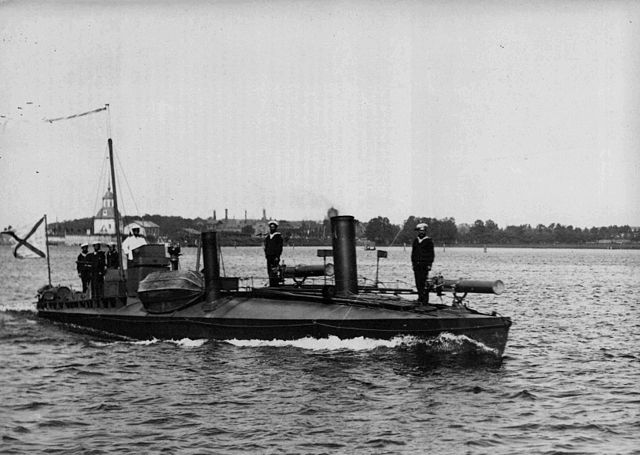
Imperial Russia jumped on the bandwagon on torpedo boats early on, starting in 1877 as the Whitehead model was just being sold. The first use of torpedoes by Russia was during the Russo-Turkish War (1877–1878), where such vessels were classified as "minnyi kater", or "mine/torpedo launch". The only seagoing ship available at the time was Vzryv (160 tons, see later) which torpedo armament called her "minnoye sudno" or mine/torpedo vessel". By 1978 the Russians ordered no less than 133 20-30-ton ships called "minonoska" or "minonosnaya lodka" or "mine/torpedo boat" but later reclassified as "torpedo boat, 2nd class".
 Russian spar-torpedo vessel at the time of the Crimean war.
Russian spar-torpedo vessel at the time of the Crimean war.
Use of torpedoes in the 1877-78 war
At the start of the war, the Russian fleet in the Black Sea was dwarved by the Turkish fleet and the Turks blocked the Dardanelles so no reinforcement ships could be sent from the Baltic. There was no time either to build new large ships. Thus the first spare-torpedo and "mine carrier" of the Russian Imperial Navy had to operate in the Danube flotilla, with four part of the "active defense" steamship force and acting as auxiliary cruiser. There was the “Grand Duke Konstantin” whch operated off Caucasus (Sukhum, Batum, Gagry) and laid mines in the mouth of the Danube while the torpedo cutters No. 1 and No. 2. were Assigned to Odessa and took part in on of the raids of "Grand Duke Constantin."
Imperial yachts were used to carry torpedoes by default of dedicated vessels; In the Danube flotilla, alone, there were the "Firstborn", "Dont touch me", "Greig", "Spiridov", "Peter the Great" (later renamed "Pretty Woman"), "General Admiral", "Ksenia" (from the frigate "Olaf"), "Varangian", "Dzhigit", "Experience", "Power", "Princess" and “Tsarevich” (former boat “Swallow” (“Rindunica”), provided for the duration of the war (after it began) by the Romanian government.
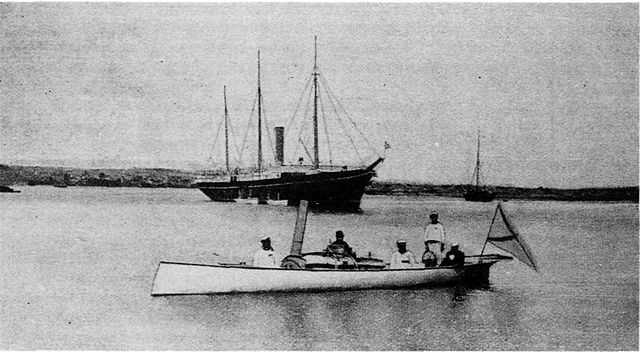
Boats tailor-built for the Danube flotilla: “Joke” (Thornycroft pleasure boat for the heir to the throne (future Emperor Alexander III) with steel hull and “Mina” (built at Berda plant St. Petersburg with a copper hull and originally called “Mab”. It was purchased under permission of Grand Duke Nikolai and delivered after the start of the hostilities. It had a single-cylinder engine rated for 5 horsepower, 6 knots, down to 2-3 knots when fighting current and headwind.
These were were armed with two bow 12 meters long spar torpedoes using a system of yokes, thimbles and forks mounted on capstan attached directly to the hull. Sime used two stern poles with mines to be inserted but was soon abandoned.
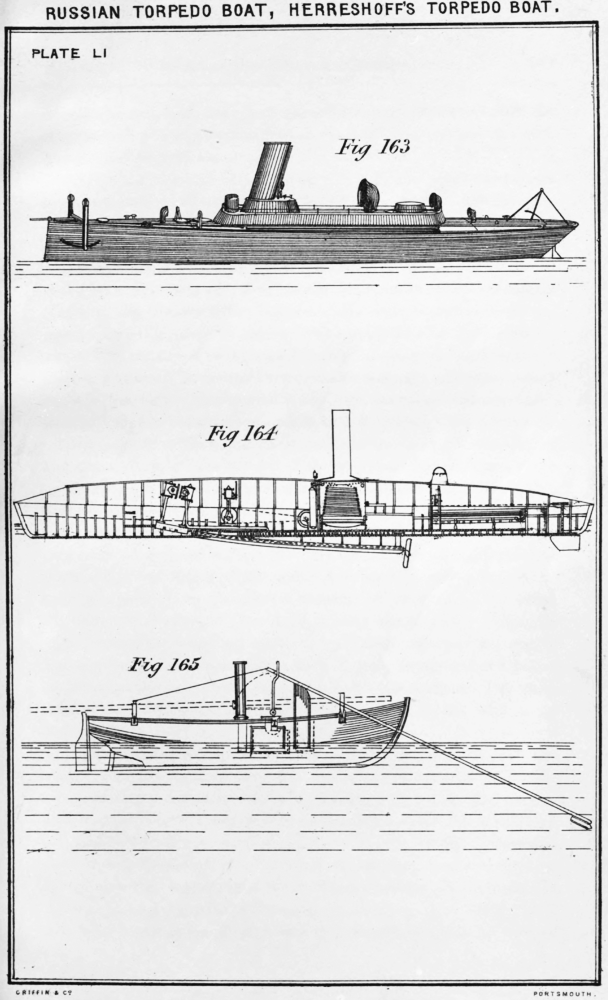
The Russian usually used powder charges of 8 pounds (3.3 kg), 15 pounds (6.15 kg) and 60 pounds (24.6 kg). These "commando operations", the ship needed to close in to 4-5 meters and the detonation was carried out by pressure fuse (Captain Trumberg system) or electric fuse (galvanic battery).
The "Grand Duke Konstantin" fleet comprised the "Chesma" “Sinop” "Navarin" and "Minyor" (later "Sukhum"), given named by December 26, 1876.
“Chesma” had some seaworthiness but the others only used calm weather at 6 knots max. These were 6 tons, 20 m cutters armed with towed mines or “lionfish” using the Makarov system, mines kept afloat by a buoy and equipped with a 3-pound (49.2 kg) gunpowder charge, towed by a 35-40 meters cable. The mine was winged in order to stay away from the wake. Eventually Chesma and Sinop were equipped to launch Whitehead torpedoes and were renamed "mine cutters".
1880s Russian Torpedo Boats
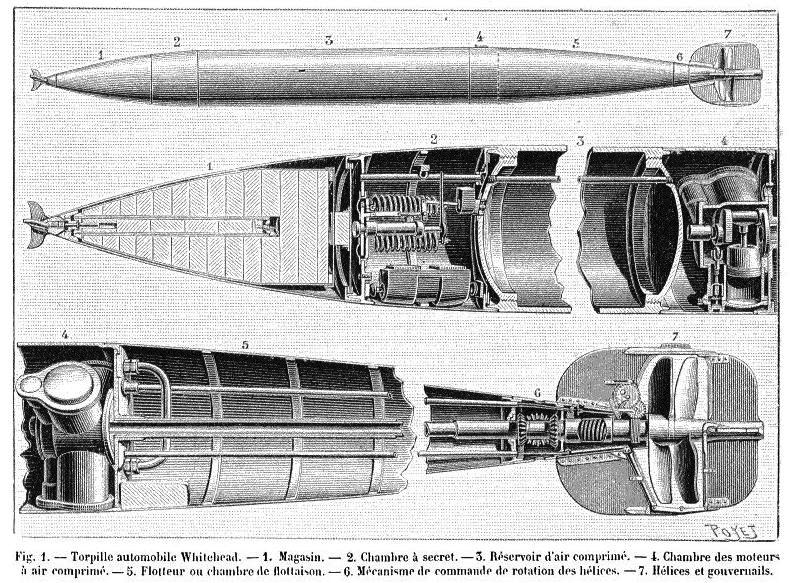 Whitehead torpedo
Whitehead torpedo
 Schwartzkopf torpedoes (for Schichau models)
Schwartzkopf torpedoes (for Schichau models)

Its very first torpedo boats (1st class by default) was even built in Russia, at Baltic Works, launched in 1877 and relatively large for its day. However from the 1880s many foreign small torpedo boats were ordered for comparisons, leading to an early period which saw experiments before setting on Schichau for the first constituted classes and Normand for a last comparison rounds, and then construction of small series of single ships by Russian Yards, Nicolaiev, New Admiraty, Nevski, Crichton Abo, Putilov and Izhora Works, Bellino-Fendrich. There were no second classes, all these were named after islands and later numbered. Classified as "minonosets", or "mine/torpedo carrier" were translated by most authors as "torpedo boat 1st class" and later "destroyer" if the displacement was above 200 tons, which was the case for the Sokol class (see
Russian WW1 Destroyers). Starting in 1907 the largest of these were redesignated as "eskadrennyi minonosets" or "squadron torpedo carrier", "destroyers" in most publications.
By 1905 as much as Normand seemed the preferred design, following the influence of the Young School some were also ordered from yarrow to keep an eye on recent British developments as well. By that stage, they saw action in WWI but the type fell in disregard after the Russo-Japanese war. Russian would return to torpedo boats with the unique 500t type as part of the 1915 emergency program for the Baltic and black sea, before the whole plan was cancelled.
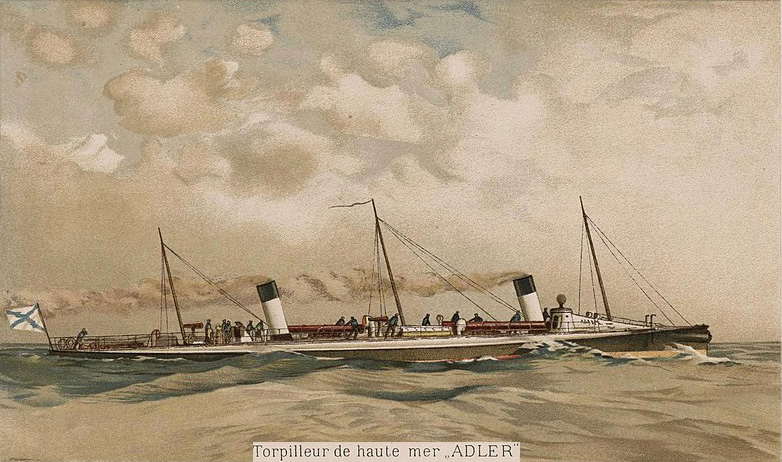 TB Adler
TB Adler
The larger Russian boats are described individually below, but except for the first one they were preceded by a large number of small boats. In the Russo-Turkish War of 1877/1878 most of the boats used spar or towing torpedoes, and only Tchesma, which had a tube rigged under the keel, and the Sinop, which discharged her torpedo from a raft secured alongside, employed Whiteheads. None of the boats used this war appears to have been longer than 68ft and most were considerably smaller, but in 1877 the construction of 100 Yarrow-designed was begun by the Russian yards in the Baltic. These boats were 75ft overall by 10ft 6in and displaced 24.5t, with a speed of 17kts and engines of 200-220 ihp.
They could be transferred between the Baltic and Black Sea by rail. Some had a single 15in TT but most were originally armed with spar torpedoes and/or the ‘fired’ torpedo, a 9in diameter weapon propelled to about 200ft by a gunpowder launching charge. None was actually built by Yarrow though four sets of machinery were supplied by them, and of the Russian yards the Baltic Works and Baird were the principal builders. All the above 100 boats seem to have been launched in 1877 or 1878, and another 15 boats of different designs but of similar size had been acquired by the end of 1880 mostly from Schichau.
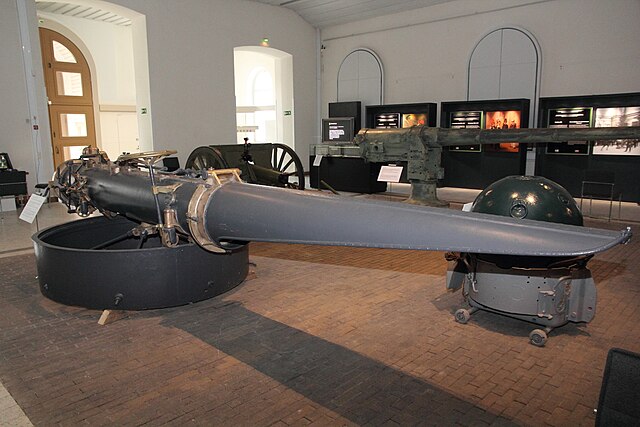 Model 1904 Torpedo Tube
Model 1904 Torpedo Tube
Very few small boats were added subsequently, except for ten 90ft, 37t boats from Nixon of New Jersey in 1905. These were powered by two 300hp petrol engines to give 20kts, and had a 12in training TT, but were found to be unsuitable for the Russian Navy. A list of 1896 shows 98 small torpedo boats still in use, of which 55 apparently had 1-15in TT and the rest spars, and in 1906, discounting the above petrol-engined boats, these figures had fallen to 74 and 44 boats. The above small torpedo boats were originally named, but in about 1887 they were given numbers from 51, actually 46, to 100 for boats with Whiteheads and 101 upwards for spar torpedo boats.
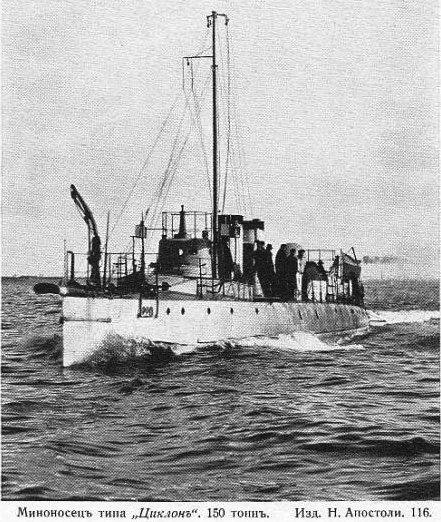 One of the last Russian TBs, derived from the French Cyclone class, N°214 class
One of the last Russian TBs, derived from the French Cyclone class, N°214 class
From 1895 these numbers were changed to 100, apparently without relevance to the former number. At the same time the larger boats, except the first, Vzruiv, were allocated numbers from 101 if in the Baltic, and from 251 if in the Black Sea. The Vladivostok boats retained their names for a time, but were then numbered 201 to 2011 while 212-223 were given to the Baltic boats launched in 1901 1902. The last of all, the Lastochka, was not numbered.
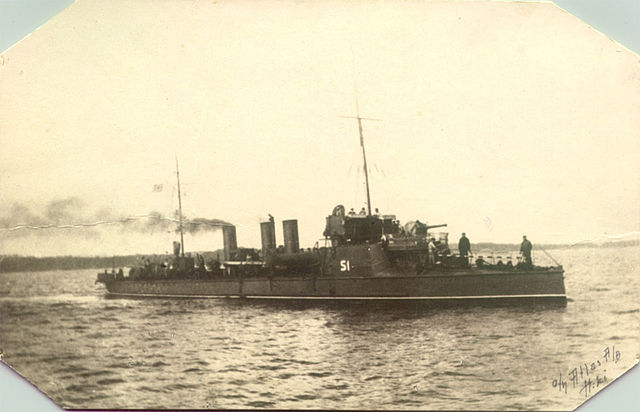 Sokol class, assimilated at the time as "torpedo boats, 1st class", then destroyers later as rhey were above 200 tonnes. These took succession of the previous TBs.
Sokol class, assimilated at the time as "torpedo boats, 1st class", then destroyers later as rhey were above 200 tonnes. These took succession of the previous TBs.
List of 1878 minonoska and beyond
| Type | Year | Built in class | Caracteristics | Sold for scrap |
|---|
| «Dragon» | 1877—1878 | 83 | 25 tons, 13 kts, 350 hp, 100—150 t coal, 1х 381mm TT, 1х 37mm/28 | 1906—1909 |
| «Russian» | 1878—1879 | 5 | 30 tons, 14 kts, 1х 381мм TT, 1х 37mm/28 gun | 1906—1909 |
| «Scorpio» | 1878—1879 | 3 | 25 tons, 12 kts, 225 hp, 1х 381mm TT, 1х 37mm/28 | 1906—1909 |
| «Onion» | 1878—1879 | 11 | 21 tons, 12 kts, 110 hp, 1х381mm TT, 1х1х37/28 | 1906—1909 |
| «Machine-gun» | 1878 | 2 | 32 tons, 13 kts, 350 hp, 1х 381mm TT, 1х 37mm/28 | 1906—1909 |
| «Mullet» | 1878 | 1 | 13 tons, 12 kts, 1х 381mm TT | 1906—1909 |
| «Sulin» | 1878 | 4 | 25 tons, 12 kts, 260 hp, 1х 381mm ТT, 1х 37mm/28 | 1906—1909 |
| Nixon type | 1904 | 10 | 35 tons, 18 kts., 400 hp, 1х450mm TT, 1х 45mm, 2х 7,62mm LMG | 1921—1950 |
| N°46 Class | 1889 | 1 | 17 tons, No data | 1889—1900 |
Russian Torpedo Cruisers
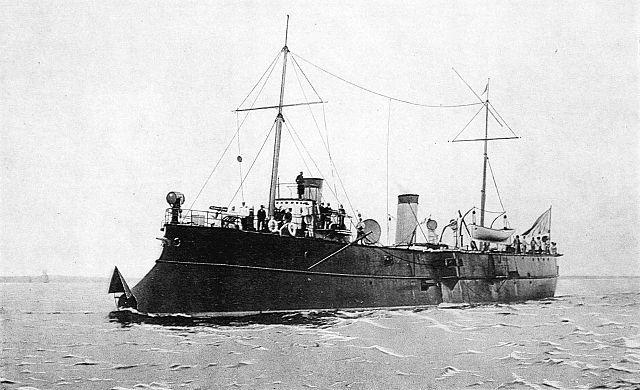 Leytnant ilyin as built
Leytnant ilyin as built
Russia tried also larger torpedo ships, in that case "cruisers", LEYTENANT ILYIN (1887), KAPITAN SAKEN (1889), Abrek (1897) as well as the KAZARSKIY class torpedo cruisers (1890-1895) which comprised Kazarskiy, Voevoda, Posadnik, Vsadnik, Gaydamak, and Griden, first three built at Schichau, second two at Crichton, Abo and last at Nikolayev Admiralty Yards. They had different fates in 1917-18, one sunk 1904 (attack on Port Arthur), one captured by the Reds, two by the Finns one scuttled, all re-rated as dispatch vessels 1907.
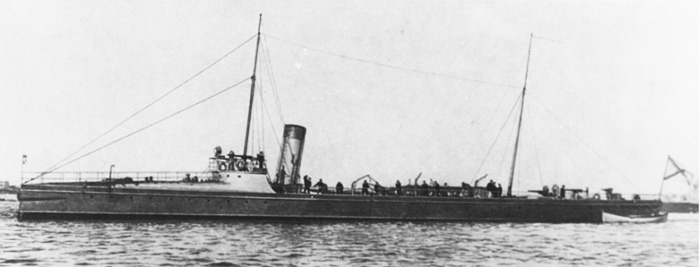 The Kazarsky class, Courtesy of Mr. Boris V. Drashpil of Margate, Florida, 1984. src
The Kazarsky class, Courtesy of Mr. Boris V. Drashpil of Margate, Florida, 1984. src
Kazarsky was still used as minelayer in 1925. Lt. Ilyin was a 600 tonnes ship made in Carr & McFerson, St. Petersburg. She became a dispatch vessel on 10.1907, and was stricken in 6.1911. Capt. Saken was builk at Nikolayev Admiralty and became an auxiliary in 1907, fate unknown. Abrek was from Crichton, Abo (later in Finland) and had the longest carrer. She became like the others a dispatch vessel by October 1907, a board guard ship in Sept. 1908, a dispatch vessel again as the war started in 1914, then a survey vessel postwar by December 1918, a dispatch vessel again by April 1926, and she was eventually hulked in June 1940.
 Torpedo cutter from Chesma in 1877. The battleship was used as a mother ship for two of such vessels.
Torpedo cutter from Chesma in 1877. The battleship was used as a mother ship for two of such vessels.
Russia has been using torpedo-armed warships since the 1870s and notably "torpedo cutters" to attack the Ottomans with the Vzryv in 1877 being its first large dedicated torpedo vessel (see later). However the first specifically designated torpedo cruiser was Leytenant Ilyin, Capt. Saken being often considered her sister ship. The six ships of the Kazarskiy class built on this, and then came the heavily-armed Abrek. With the Russo-Japanese War in 1904 construction of 24 more of these was approved and to gain time, in colaboration with Schichau.
A dedicated article will be made on those in 2025 or beyond.
Russian Torpedo Boats
 Vrzuiv (1877)
Vrzuiv (1877)
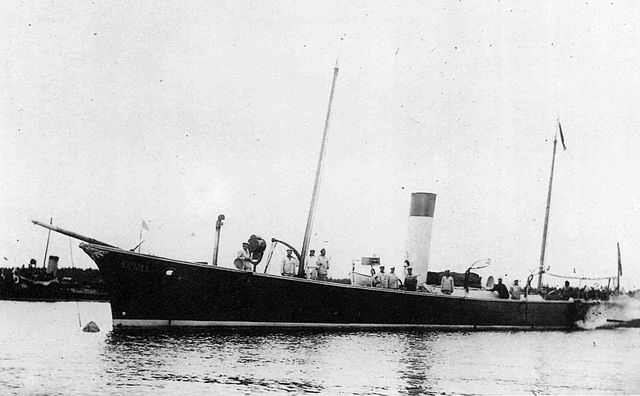
Built as a steam yacht in inspiration, first Russian dedicated type, the TTs were on either beal forward midship, ppointed ahead. Later in career she became a torpedo school tender. Top speed down to 800 ihp and 13.5 kts. Stricken 1908
Specs:
160t, 36.47 x 4.93 x 3.38 m, 1 loco boiler shaft VC, 1000 hp 17 kts declared 16t coal. Armed with 2x 1pdr revolver, 2x 381 mm TTs.
 Batum (1880)
Batum (1880)
picc
Yarrow type, later N°472, Black sea fleet. Ram bow, turtle back, 2 funnels abreast, partly above water rudder and rop rudder at the bow. Two fixed bow TTs under turtle belt, two spare on deck. She was the first TB to cross the Mediterranean. Stricken 1908
Specs:
43 tons, 29.41 x 3.39 x 1.9m, 1 loco boiler shaft VC 500 ihp 22.5 kts, 10t coal. 2x 1-pdr revolver, 2 TTs 381mm.
 Sukhum (1883)
Sukhum (1883)
The Sukhum was also British built at Thonycroft, later Number 167. Black sea fleet, ram bowed, turtle deck (fixed TTs), two funnels abreast, 3 masts for 2 sails, 1/4 inch armour either side near machinery space. Stricken 1808.
Specs:
64t, 34.42 x 3.81 x 1.98m, 1 loco boiler shaft VC, 704 ihp, 17.9 kts, 10t coal; 2x 19dr, 2x 381mm TTs
 Poti (1883)
Poti (1883)
Poti was French built at Normand, le Havre, successful early type, two funnels abreast two fixes TTs bow. In 1902 she was converted to fire oil. Stricken 1908.
Specs:
63t, 37.97 x 3.05 x 2.03t, 1 loco boiler shaft VC, 575 ihp 18 kts, 11t coal, 2x 1-pdr, 2x 381 mm TT
 Ghelendjik (1884)
Ghelendjik (1884)
Bleack sea fleet TB, French built at La Seyne, Toulon, France. Three small masts, two funnels abreast, fixed TTs. Stricken 1908.
Specs:
70.5 ton, 37.40 x 3.78 x 2.13m, 1 shaft VC 520 ihp 18 kts coal 11t, 1x 1pdr, 1x1 pdr revolver, 2x 381mm TTs
 Gagri (1884)
Gagri (1884)
Black sea fleet TB built at Claparede NyD Rouen France, with two fixed bow TTs, converted to oil in 1902. Stricken 1908
Specs:
80t, 36.75 x 4.06 x 1.98m, 1 loco boiler shaft VC 574 ihp 17.8 kts 12t coal. 1x 1pdr, 1x 1pdr revolver, 2x 381mm TTs
 Kotlin (1885)
Kotlin (1885)
First Russian TB (proper type), Baltic fleet. Built at Baltic Works; She had a bow rounded at top with a spur, curved deck forward covering two fixed TTs, two funnel abreast. The TT were difficult to reload. Not a success, with 18 kts intended, 16 kts achieved. Stricken 1907.
Specs:
67t, 37.95 x 3.94 x 1.37m, 1 loco boiler VC 472 ihp, 16.5 kts light, coal 14t. 2x 1-pdr revolver, 2x 381mm TTs
 Viborg (1886)
Viborg (1886)
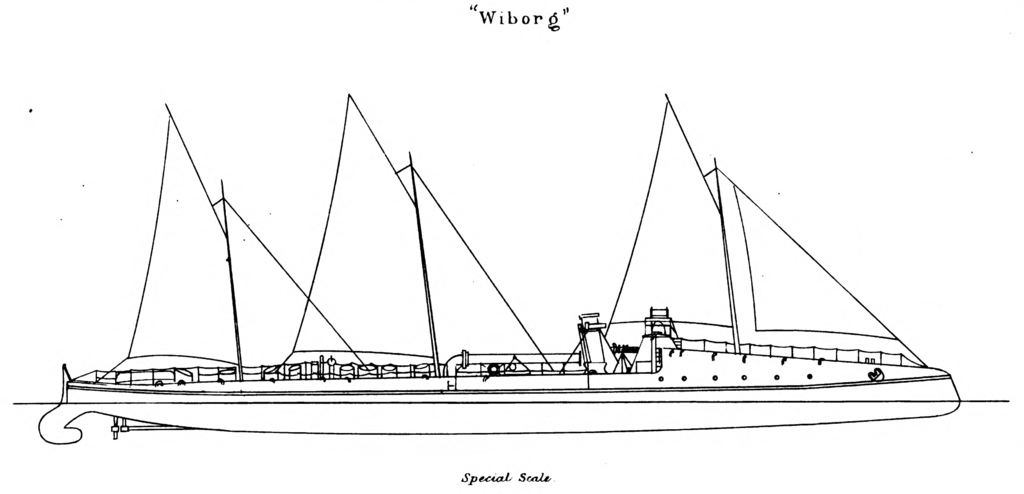
First large fleet Russian TB, British built at Clydebank. She had a rounded ram bow, long turtrle deck forward, three tall masts for sails, two funnels abreast. Two fixed bow TTs, one revolving aft of the single raked funnel, six spares. Converted to oil in 1893, 9t. She was stricken in 1910. She was one of the best known and recoignizable types of her time.
 Specs:
Specs:
166t, 43.43 x 5.18 x 2.13 m, 2 loco boilerts, 2 shafts VC 1300 ihp 20 kts, 40t coal. 2x 1pdr revolver, 3x 381mm (15 in) TTs.
 Abo class (1886)
Abo class (1886)
Abo, Vindava, Libaya
First class of coastal TBs this time ordered to Germany, Schichau for the Baltic fleet. Used Schwartzkopf torpedoes. Later numbered 108-110. Three signal masts, fore and aft coinning towers, two rudders, one shaft, straight stem, rounded stern, two fixed bow TTs, 4 spares.
Specs:
76t, 38.50 x 4.52 x 1.90m, 1 loco boiler shafts VC, 640 ihp, 19.3 to 20 kts on trials, 18t coal. 4x 1pdr revolver, 2x 381mm TTs
 Yalta class (1886)
Yalta class (1886)
Yalta, Novorossisk, Tchardak, Kodor, Kilia, Keni
Schichau type for the Black sea fleet. Numbered later 261-266. Improved Abo types, with TE engines. Had for some four 1-pdr revolver guns, all fitted for oil fire in 1899-1902, stricken 1911-13.
Specs:
85-90t, 38.55 x 4.57 x 2.06m, 1 loco boiler shafts VTE 900 ihp 20-20.8 kts coal 21t max. 2x 1pdr revolver, 2x fixed 381mm TTs
 Izmail class (1886)
Izmail class (1886)
Izmail, Lakhta, Luga, Narva
Russian copies of the Poti class, not sucessful, intended for the Black sea fleet, first built at nicolaiev, others at New Admiralty. Later N°276, 105-107 in order. Last rthree reboilerd with Yarrow boilers, oil fuel in 1899, Izmail 1902. Stricken 1907-10
Specs:
73-76t, 38.89 x 3.53 x 2.30 m, 1 loco boiler shaft VC 296 ihp 15.8 kts, 17t coal. 4x 1pdr revolver, 2x 381mm TTs
 Sveaborg class (1886)
Sveaborg class (1886)
Sveaborg, Revel
Two Normand built, very satisfactory boats with two fixed bow TTs, one training, Baltic fleet but later sent to Pacific fleet. Numbered 205,206. Both stricken 1911
Specs:
96-107.5t, 46.80 x 3.43 x 2.64 or 3.73 x 2.51m. 1 Normand boiler shaft VTE 737 ihp 19.2 kts or 837 ihp; 19.7 kts; 2x 1pdr revolver, 3x 381mm TTs
 Sutchena class (1887)
Sutchena class (1887)
Sutchena, Yantchikhe
Two Schichau plan boats built in Russia, Nevski yard, for the Naltic fleet, improved Abo class. Numbered 201-202. Single funnel; straight stem, rounded stern, three masts, two fixed bow TTs, later desmounted and sent by rail in section to Vladivostok. Stricken 1911.
Specs:
76t, 39 x 4.52 x 1.85 m, 1 loco boiler shaft VC 16-17 kts 29t coal. 2x 1pdr revolver, 2x 381mm TTs
 Anakria (1889)
Anakria (1889)
Black sea fleet Schichau boat, single funnel, 3 masts, fixed TTs, one deck training, reboilered oil 1900. Fastest Russian TB at this point. Numbered 260. Took part in WWI, stricken 1917.
Specs:
100t, 38.55 x 4.78 x 2.08 m, 1 loco boiler shaft VTE 1100 ihp 21 kts coal 18t, 2x 1pdr revolver, 2x 381mm TTs
 Sugari class (1889)
Sugari class (1889)
Sugari, Ussuri
Two larger fleet TB built for the Baltic fleet at Crichton, Abo. Had two bow TTs, numbered 203, 204. Sent in sections at Vladivostok in 1904. Ussuri was scuttled on 30 June 1904, Sungari stricken in 1911.
Specs:
175t, 41.20x 5 x 2.64m, 2 loco boilers shafts VTE, 1956 ihp 20.3 kts, the other 2039 ihp, 1935 kts. 30t coal. Armed with 3x 1pdr revolver, 3x 381mm TTs
 Adler (1890)
Adler (1890)
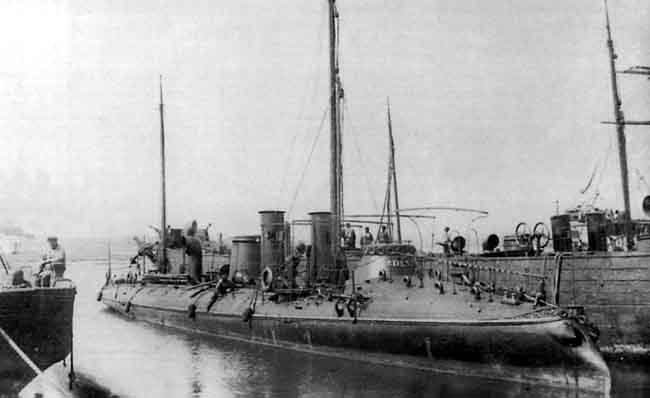 Adler just completed in 1890.
Adler just completed in 1890.
Experimental large TB for the Black sea fleet, built at Schichau, usual one funnel, straight stem, rounded stern, one fixed TT bow, 2 training on deck. Conv. oil 1900. Fastest Russian TB before Latoshka. N°259. Took part in WWI. Stricken 1917.
Specs:
164t, 47 x 5 x 2 m, 1 loco boiler shaft VTE 2000 ihp 26.7 kts 20t coal. 2x 1pdr revolver, 3x 381mm TTs
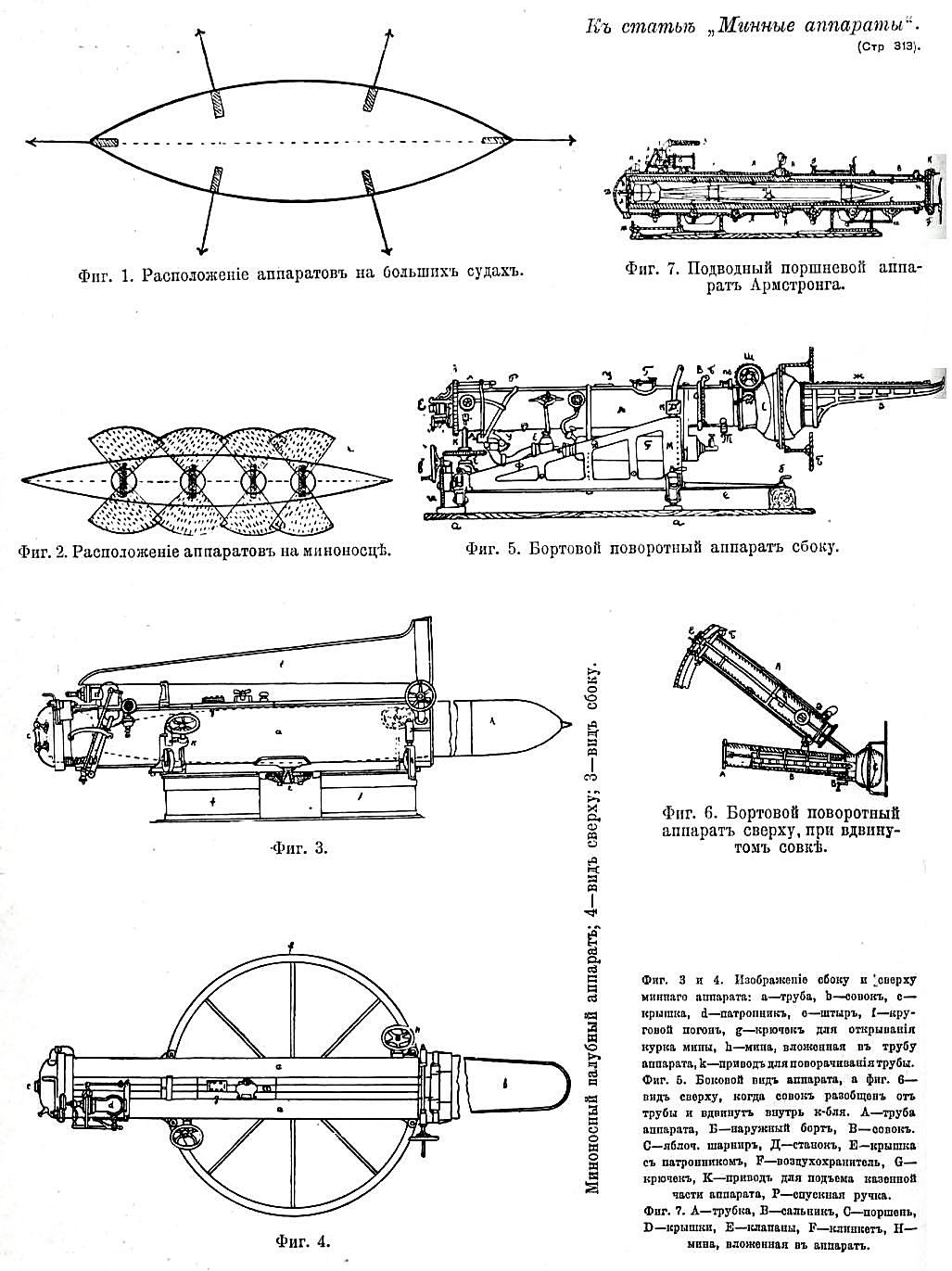 Early Torpedo Tubes
Early Torpedo Tubes
 Elenes class (1890)
Elenes class (1890)
Ekenes, Borgo
Two Crichton-Abo built TBs for the baltic, later numbered 117 and 207. Borgo was sent in sections to Vladivostock and lost in 1900. Her sister Ekenes was stricken 1910.
Specs:
106t, 41.66 x 4.47 x 2.57 m, 1 loco boiler shaft VTE 1245 ihp 20 kts 18t coal. 2x 1pdr revolver, 3x 381mm TTs
 Bierke class (1890)
Bierke class (1890)
Bierke, Rotchensalm, Gapsal, Moonzund
photo
Putilov Yard boats (the first) made for the Baltic fleet, ram bows, two masts, fore and aft sails optional. Made on Ekenes plans, shorter. Two trainable TTs 35° each side. Numbered 111-114. N°112 reboilered Yarrow oil fire 1899, 114 too. All stricken 1910.
Specs:
81t, 38.4 x 4.47 x 2.57 m, 1 loco boiler shaft VTE 1000 ihp 19 kts 20t coal. 2x 1pdr revolver, 3x 381mm TTs
 Dago class (1891)
Dago class (1891)
Dago, Kotka, Kronshlot, Seskar
Four Crichton Abo and Izhora built initially for the Baltic fleet. One, Kotka was sent to the Black sea. One fixed bow TT, one training aft. Numbered 118, 256, 123 and 124. N°256 nevame a seaplane tander and TB from 1917 to 1937. The others were stricken in 1910.
Specs:
104t, 46.6 or 46.8 x 3.91 x 2.34-2.44 m, 1 loco boiler shaft VTE 1000 ihp 19 kts 15t coal. 2x 1pdr revolver, 2x 381mm TTs
 Anapa class (1891)
Anapa class (1891)
Anapa, Aitodor
Designed for the Black sea fleet, no data available. Built at Bellino-Fendrich yard in Odessa. Both took part in WWI, stricken 1917. Numbered 252 and 253.
Specs:
96t, 38.4 x 4.47 x 1.52 m, 1 loco boiler shaft VTE 1100 ihp 19 kts 15t coal. 2x 1pdr revolver, 2x 381mm TTs crew 18
 Pernov (1892)
Pernov (1892)
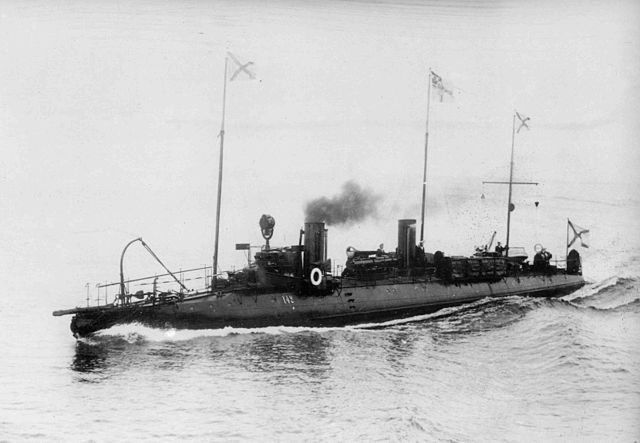
Two funnel Normand design, version of the French Dragon class, one bow TT, two training between funnels and aft. Reboilered Yarrow 1899, diverging speed src, 1800 ihp 25.45 kts
Specs:
120t, 42 x 4.5 x 2.06 m, 1 loco boiler shaft VTE 2000 ihp 26 kts 16t coal. 2x 1pdr revolver, 3x 381mm TTs crew 21
 Setrorestsk (1893)
Setrorestsk (1893)
Smaller version of Pernov ordered also to Normand. Fixed bow TTs, one trainable deck TT, 1350 ihp adnd 24.5 kts on trials on 76.5t. Numbered 103, stricken 1910.
Specs:
80t, 42 x 4.5 x 2.06 m, 1 loco boiler shaft VTE 1300 ihp 23 kts 17t coal. 2x 1pdr revolver, 2x 381mm TTs crew 21
 Tosna class (1893)
Tosna class (1893)
Tosna, Domesne, Aspe, Tranzund, Nargen, Gogland
Russian versions of the Schichau boats, first four at Putilov, last two at Izhora. The former were reboilered with Yarrow models oil fired. Numbered 115, 116, 125, 126, 121, 122. All stricken in 1910.
Specs:
85-99t, 38.8-39 x 4.65-72 x 1.9-2.08 m, 1 loco boiler shaft VTE 1000 ihp 20 kts 17t coal. 2-3x 1pdr revolver, 2x 381mm TTs crew 21
 Polangen class (1894-96)
Polangen class (1894-96)
Polangen, Pakerorrt, N°127-273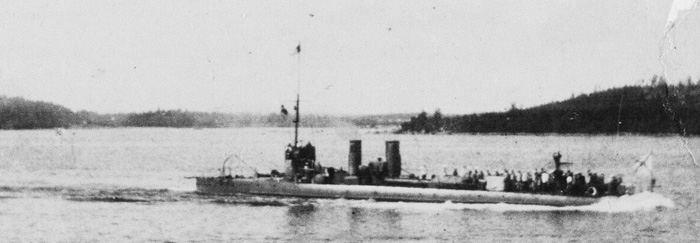
Russian versions of the Pernov, built in large series (largest of all Russian TBs), 2 at Crichton, 8 at Izhora, 6 at Nevski, 4 at Nikolaiev, 1894-1897. Numbered 119-142 and 270-273. N°270 and 272 went to the Black sea fleet.
Specs:
120t, 42 x 4.5 x 2.06 m, 1 loco boiler shaft VTE 2000 ihp 23.2 kts 20t coal. 2x 1pdr revolver, 3x 381mm TTs crew 21
 N°131 class (1895)
N°131 class (1895)
N°131, 132, 268, 269
Shorter, but heavier versions of the Polangen, built at Izhora and Nicolaiev. One fixed bow TT, one aft deck trainable. 269 was lost in a collision, 132 became TS, two others scrapped 1910.
Specs:
100t, 38.55 x 4.77 x 2.08 m, 1 loco boiler shaft VTE 1000 ihp 21 kts 20t coal. 2x 1pdr revolver, 2x 381mm TTs crew 18
 N°201 class (1899)
N°201 class (1899)
N°208, 209, 210, 211
Polangen type boats, built at New Admiralty Yard, but slower, with more range, larger bunkers. Shipped to Vladisvostok in sections, N°208 hit a mine and sunk on 17 July 1904. The remainder were stricken in 1911 and 1915.
Specs:
120t, 42 x 4.5 x 2.06 m, 1 loco boiler shaft VTE 1460 ihp 18.5 kts 40t coal. 2x 1pdr revolver, 3x 381mm TTs crew 21
 N°212 class (1901)
N°212 class (1901)
N°212, 213
3 Funnels Yarrow type built in Crichton, Abo, launched 1901 with a fore and aft conning towers and used as minesweepers in WWI. Stricken 1921 and 1925.
Specs:
186t, 52.35 x 5.25 x 1.47 m, 2 shaft VTE 3800 ihp 24 kts 60t coal. 3x 1pdr, 3x 381mm TTs crew 26. Later 2x 3-pdr, 2 TTs as minesweepers.
 N°214 class (1902)
N°214 class (1902)
N°214-223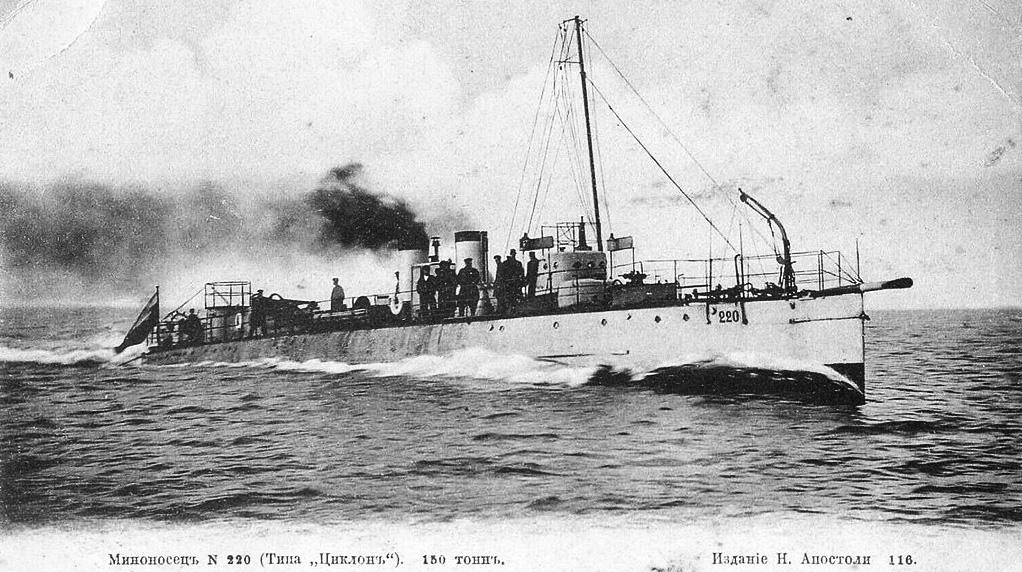 N°220, photo by Apostoli, on trials
N°220, photo by Apostoli, on trials
Last and largest serie, first five built at Nevsky, last five at Crichton. Russian copies of the French large TB of the Cyclone class, twin TT bank deck training. The survivors of WWI (all but 221, foundered 1904), 223 stricken in 1912, were stricken at unknown dates, from 1921 to 1930.
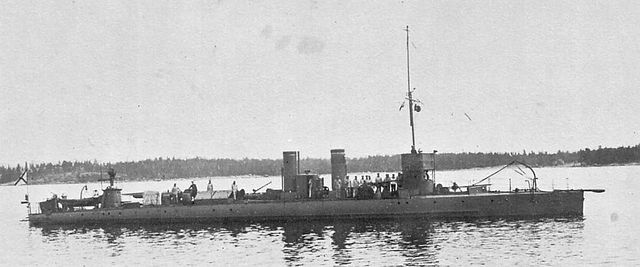 N°214
N°214
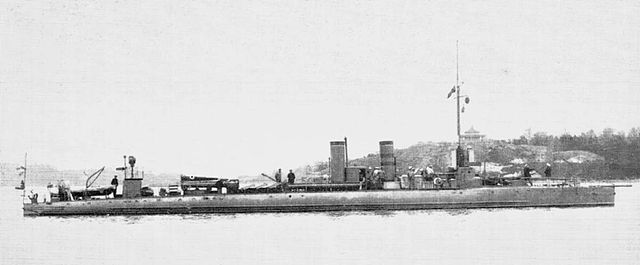 N°218
N°218
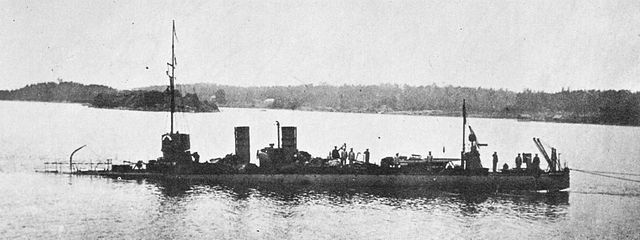 N°218 after hitting a mine forward
N°218 after hitting a mine forward
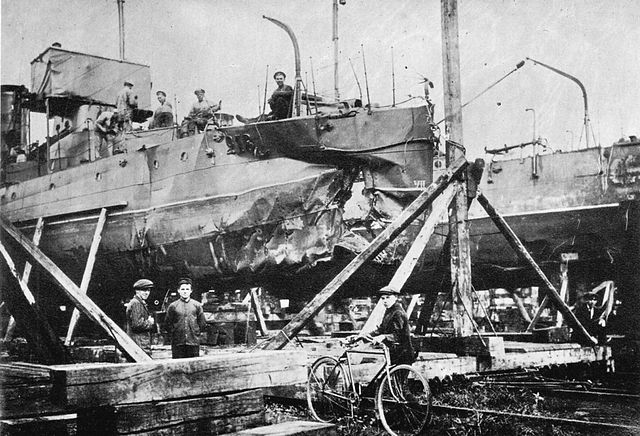 N°218 in repairs in 1915
N°218 in repairs in 1915
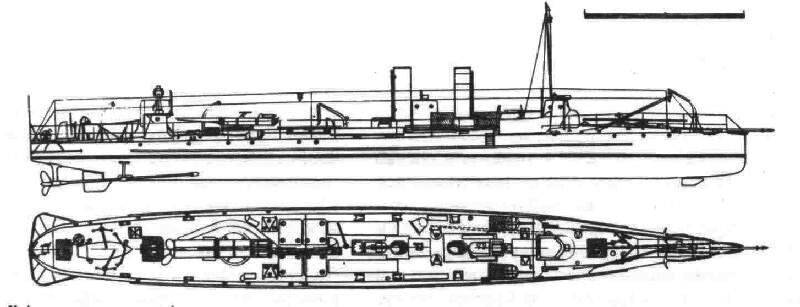 Specs:
Specs:
150t, 45 x 4.65 x 2.67 m, 2 shaft VTE 3700 ihp 29 kts 30t coal. 2x 3pdr, 2x 381mm TTs crew 28.
 Latoschka
Latoschka
Experimental Yarrow boat, originally named Caroline. Same hull form as the Yacht Tarantula of Vanderbilt, with an HP engine on the port shaft, and KP on starboard, VTE on center shaft. TT port and starboard fwd of the fore funnel, aft centerline. This was the first turbine TB of the Russian Navy and one of the first turbine warship ever.
Specs:
140t, 46.5 x 4.65 x 1.52 m, 3 shaft, 2 Yarrow Boilers, 2 Rateau turbines, 1 VTE, 2000+250 ihp, 26.4 kts. 2x 3pdr, 3x 381mm TTs crew 23.
 1915 Emergency Program 500 tonners
1915 Emergency Program 500 tonners
This is the only projected "modern" TBs designed by Russia after it shifted on larger TBs such as the Sokol class post 1905, later assimilated as destroyers based on tonnage. Technically at 500 tons, these planned ships were to be "small destroyers", but were classed as TBs nonetheless in documentation.
This was an ambitious wartime plan, called the 1915 emergency naval plan, as authorized to deliver 12 for the Black sea fleet and 24 for the Baltic fleet. No data found, no plans, they should have been seagoing vessels capable of 30 kts, armed with trhee 4-in(102mm) guns/60 and four 18-in or 457mm torpedo tubes in two twin banks.
In 1916, the plan was ditched to concentrate on 12 repeat Kerch class large destroyers and five 2500t new destroyers inspired by the German S-113 ordered in 1916 at the Russo-Baltic Yards instead of the TBs. The order was confirmed by October 1917 but little has been done apart plans.
Read More/Src
Books
Afonin, N. N.; Balakin, S. A. (2004). Миноносцы типа "Сокол" ["Sokol"-Class Torpedo Boats]. «Morskaia kollektsiia» Saint Petersburg
Joutsi, Juha (September 2021). "The Sokol Class Torpedo Boats in Finnish Service". Warship International. LVIII (3)
Links
navypedia.org/ russian TBs
worldnavalships.com russian torpedo gunboats
en.wikipedia.org/ List of destroyers Imperial Russian Navy
ru.wikipedia.org/
ru.wikipedia.org/
ru.wikipedia.org/
ru.wikipedia.org/
navsource.narod.ru/
web.archive.org minonoski.html
samlib.ru/
historius.narod.ru/
http://www.warships.ru/
mkmagazin.almanacwhf.ru/
commons.wikimedia.org/ Category:Torpedo boats of the Russian Empire
Videos
https://youtu.be/-MYkcqKfKzs
 Imperial Russia jumped on the bandwagon on torpedo boats early on, starting in 1877 as the Whitehead model was just being sold. The first use of torpedoes by Russia was during the Russo-Turkish War (1877–1878), where such vessels were classified as "minnyi kater", or "mine/torpedo launch". The only seagoing ship available at the time was Vzryv (160 tons, see later) which torpedo armament called her "minnoye sudno" or mine/torpedo vessel". By 1978 the Russians ordered no less than 133 20-30-ton ships called "minonoska" or "minonosnaya lodka" or "mine/torpedo boat" but later reclassified as "torpedo boat, 2nd class".
Imperial Russia jumped on the bandwagon on torpedo boats early on, starting in 1877 as the Whitehead model was just being sold. The first use of torpedoes by Russia was during the Russo-Turkish War (1877–1878), where such vessels were classified as "minnyi kater", or "mine/torpedo launch". The only seagoing ship available at the time was Vzryv (160 tons, see later) which torpedo armament called her "minnoye sudno" or mine/torpedo vessel". By 1978 the Russians ordered no less than 133 20-30-ton ships called "minonoska" or "minonosnaya lodka" or "mine/torpedo boat" but later reclassified as "torpedo boat, 2nd class".
 Russian spar-torpedo vessel at the time of the Crimean war.
Russian spar-torpedo vessel at the time of the Crimean war.
 Boats tailor-built for the Danube flotilla: “Joke” (Thornycroft pleasure boat for the heir to the throne (future Emperor Alexander III) with steel hull and “Mina” (built at Berda plant St. Petersburg with a copper hull and originally called “Mab”. It was purchased under permission of Grand Duke Nikolai and delivered after the start of the hostilities. It had a single-cylinder engine rated for 5 horsepower, 6 knots, down to 2-3 knots when fighting current and headwind.
These were were armed with two bow 12 meters long spar torpedoes using a system of yokes, thimbles and forks mounted on capstan attached directly to the hull. Sime used two stern poles with mines to be inserted but was soon abandoned.
Boats tailor-built for the Danube flotilla: “Joke” (Thornycroft pleasure boat for the heir to the throne (future Emperor Alexander III) with steel hull and “Mina” (built at Berda plant St. Petersburg with a copper hull and originally called “Mab”. It was purchased under permission of Grand Duke Nikolai and delivered after the start of the hostilities. It had a single-cylinder engine rated for 5 horsepower, 6 knots, down to 2-3 knots when fighting current and headwind.
These were were armed with two bow 12 meters long spar torpedoes using a system of yokes, thimbles and forks mounted on capstan attached directly to the hull. Sime used two stern poles with mines to be inserted but was soon abandoned.
 The Russian usually used powder charges of 8 pounds (3.3 kg), 15 pounds (6.15 kg) and 60 pounds (24.6 kg). These "commando operations", the ship needed to close in to 4-5 meters and the detonation was carried out by pressure fuse (Captain Trumberg system) or electric fuse (galvanic battery).
The "Grand Duke Konstantin" fleet comprised the "Chesma" “Sinop” "Navarin" and "Minyor" (later "Sukhum"), given named by December 26, 1876.
“Chesma” had some seaworthiness but the others only used calm weather at 6 knots max. These were 6 tons, 20 m cutters armed with towed mines or “lionfish” using the Makarov system, mines kept afloat by a buoy and equipped with a 3-pound (49.2 kg) gunpowder charge, towed by a 35-40 meters cable. The mine was winged in order to stay away from the wake. Eventually Chesma and Sinop were equipped to launch Whitehead torpedoes and were renamed "mine cutters".
The Russian usually used powder charges of 8 pounds (3.3 kg), 15 pounds (6.15 kg) and 60 pounds (24.6 kg). These "commando operations", the ship needed to close in to 4-5 meters and the detonation was carried out by pressure fuse (Captain Trumberg system) or electric fuse (galvanic battery).
The "Grand Duke Konstantin" fleet comprised the "Chesma" “Sinop” "Navarin" and "Minyor" (later "Sukhum"), given named by December 26, 1876.
“Chesma” had some seaworthiness but the others only used calm weather at 6 knots max. These were 6 tons, 20 m cutters armed with towed mines or “lionfish” using the Makarov system, mines kept afloat by a buoy and equipped with a 3-pound (49.2 kg) gunpowder charge, towed by a 35-40 meters cable. The mine was winged in order to stay away from the wake. Eventually Chesma and Sinop were equipped to launch Whitehead torpedoes and were renamed "mine cutters".
 Whitehead torpedo
Whitehead torpedo
 Schwartzkopf torpedoes (for Schichau models)
Schwartzkopf torpedoes (for Schichau models)
 Its very first torpedo boats (1st class by default) was even built in Russia, at Baltic Works, launched in 1877 and relatively large for its day. However from the 1880s many foreign small torpedo boats were ordered for comparisons, leading to an early period which saw experiments before setting on Schichau for the first constituted classes and Normand for a last comparison rounds, and then construction of small series of single ships by Russian Yards, Nicolaiev, New Admiraty, Nevski, Crichton Abo, Putilov and Izhora Works, Bellino-Fendrich. There were no second classes, all these were named after islands and later numbered. Classified as "minonosets", or "mine/torpedo carrier" were translated by most authors as "torpedo boat 1st class" and later "destroyer" if the displacement was above 200 tons, which was the case for the Sokol class (see Russian WW1 Destroyers). Starting in 1907 the largest of these were redesignated as "eskadrennyi minonosets" or "squadron torpedo carrier", "destroyers" in most publications.
By 1905 as much as Normand seemed the preferred design, following the influence of the Young School some were also ordered from yarrow to keep an eye on recent British developments as well. By that stage, they saw action in WWI but the type fell in disregard after the Russo-Japanese war. Russian would return to torpedo boats with the unique 500t type as part of the 1915 emergency program for the Baltic and black sea, before the whole plan was cancelled.
Its very first torpedo boats (1st class by default) was even built in Russia, at Baltic Works, launched in 1877 and relatively large for its day. However from the 1880s many foreign small torpedo boats were ordered for comparisons, leading to an early period which saw experiments before setting on Schichau for the first constituted classes and Normand for a last comparison rounds, and then construction of small series of single ships by Russian Yards, Nicolaiev, New Admiraty, Nevski, Crichton Abo, Putilov and Izhora Works, Bellino-Fendrich. There were no second classes, all these were named after islands and later numbered. Classified as "minonosets", or "mine/torpedo carrier" were translated by most authors as "torpedo boat 1st class" and later "destroyer" if the displacement was above 200 tons, which was the case for the Sokol class (see Russian WW1 Destroyers). Starting in 1907 the largest of these were redesignated as "eskadrennyi minonosets" or "squadron torpedo carrier", "destroyers" in most publications.
By 1905 as much as Normand seemed the preferred design, following the influence of the Young School some were also ordered from yarrow to keep an eye on recent British developments as well. By that stage, they saw action in WWI but the type fell in disregard after the Russo-Japanese war. Russian would return to torpedo boats with the unique 500t type as part of the 1915 emergency program for the Baltic and black sea, before the whole plan was cancelled.
 TB Adler
The larger Russian boats are described individually below, but except for the first one they were preceded by a large number of small boats. In the Russo-Turkish War of 1877/1878 most of the boats used spar or towing torpedoes, and only Tchesma, which had a tube rigged under the keel, and the Sinop, which discharged her torpedo from a raft secured alongside, employed Whiteheads. None of the boats used this war appears to have been longer than 68ft and most were considerably smaller, but in 1877 the construction of 100 Yarrow-designed was begun by the Russian yards in the Baltic. These boats were 75ft overall by 10ft 6in and displaced 24.5t, with a speed of 17kts and engines of 200-220 ihp.
They could be transferred between the Baltic and Black Sea by rail. Some had a single 15in TT but most were originally armed with spar torpedoes and/or the ‘fired’ torpedo, a 9in diameter weapon propelled to about 200ft by a gunpowder launching charge. None was actually built by Yarrow though four sets of machinery were supplied by them, and of the Russian yards the Baltic Works and Baird were the principal builders. All the above 100 boats seem to have been launched in 1877 or 1878, and another 15 boats of different designs but of similar size had been acquired by the end of 1880 mostly from Schichau.
TB Adler
The larger Russian boats are described individually below, but except for the first one they were preceded by a large number of small boats. In the Russo-Turkish War of 1877/1878 most of the boats used spar or towing torpedoes, and only Tchesma, which had a tube rigged under the keel, and the Sinop, which discharged her torpedo from a raft secured alongside, employed Whiteheads. None of the boats used this war appears to have been longer than 68ft and most were considerably smaller, but in 1877 the construction of 100 Yarrow-designed was begun by the Russian yards in the Baltic. These boats were 75ft overall by 10ft 6in and displaced 24.5t, with a speed of 17kts and engines of 200-220 ihp.
They could be transferred between the Baltic and Black Sea by rail. Some had a single 15in TT but most were originally armed with spar torpedoes and/or the ‘fired’ torpedo, a 9in diameter weapon propelled to about 200ft by a gunpowder launching charge. None was actually built by Yarrow though four sets of machinery were supplied by them, and of the Russian yards the Baltic Works and Baird were the principal builders. All the above 100 boats seem to have been launched in 1877 or 1878, and another 15 boats of different designs but of similar size had been acquired by the end of 1880 mostly from Schichau.
 Model 1904 Torpedo Tube
Very few small boats were added subsequently, except for ten 90ft, 37t boats from Nixon of New Jersey in 1905. These were powered by two 300hp petrol engines to give 20kts, and had a 12in training TT, but were found to be unsuitable for the Russian Navy. A list of 1896 shows 98 small torpedo boats still in use, of which 55 apparently had 1-15in TT and the rest spars, and in 1906, discounting the above petrol-engined boats, these figures had fallen to 74 and 44 boats. The above small torpedo boats were originally named, but in about 1887 they were given numbers from 51, actually 46, to 100 for boats with Whiteheads and 101 upwards for spar torpedo boats.
Model 1904 Torpedo Tube
Very few small boats were added subsequently, except for ten 90ft, 37t boats from Nixon of New Jersey in 1905. These were powered by two 300hp petrol engines to give 20kts, and had a 12in training TT, but were found to be unsuitable for the Russian Navy. A list of 1896 shows 98 small torpedo boats still in use, of which 55 apparently had 1-15in TT and the rest spars, and in 1906, discounting the above petrol-engined boats, these figures had fallen to 74 and 44 boats. The above small torpedo boats were originally named, but in about 1887 they were given numbers from 51, actually 46, to 100 for boats with Whiteheads and 101 upwards for spar torpedo boats.
 One of the last Russian TBs, derived from the French Cyclone class, N°214 class
From 1895 these numbers were changed to 100, apparently without relevance to the former number. At the same time the larger boats, except the first, Vzruiv, were allocated numbers from 101 if in the Baltic, and from 251 if in the Black Sea. The Vladivostok boats retained their names for a time, but were then numbered 201 to 2011 while 212-223 were given to the Baltic boats launched in 1901 1902. The last of all, the Lastochka, was not numbered.
One of the last Russian TBs, derived from the French Cyclone class, N°214 class
From 1895 these numbers were changed to 100, apparently without relevance to the former number. At the same time the larger boats, except the first, Vzruiv, were allocated numbers from 101 if in the Baltic, and from 251 if in the Black Sea. The Vladivostok boats retained their names for a time, but were then numbered 201 to 2011 while 212-223 were given to the Baltic boats launched in 1901 1902. The last of all, the Lastochka, was not numbered.
 Sokol class, assimilated at the time as "torpedo boats, 1st class", then destroyers later as rhey were above 200 tonnes. These took succession of the previous TBs.
Sokol class, assimilated at the time as "torpedo boats, 1st class", then destroyers later as rhey were above 200 tonnes. These took succession of the previous TBs.
 Leytnant ilyin as built
Russia tried also larger torpedo ships, in that case "cruisers", LEYTENANT ILYIN (1887), KAPITAN SAKEN (1889), Abrek (1897) as well as the KAZARSKIY class torpedo cruisers (1890-1895) which comprised Kazarskiy, Voevoda, Posadnik, Vsadnik, Gaydamak, and Griden, first three built at Schichau, second two at Crichton, Abo and last at Nikolayev Admiralty Yards. They had different fates in 1917-18, one sunk 1904 (attack on Port Arthur), one captured by the Reds, two by the Finns one scuttled, all re-rated as dispatch vessels 1907.
Leytnant ilyin as built
Russia tried also larger torpedo ships, in that case "cruisers", LEYTENANT ILYIN (1887), KAPITAN SAKEN (1889), Abrek (1897) as well as the KAZARSKIY class torpedo cruisers (1890-1895) which comprised Kazarskiy, Voevoda, Posadnik, Vsadnik, Gaydamak, and Griden, first three built at Schichau, second two at Crichton, Abo and last at Nikolayev Admiralty Yards. They had different fates in 1917-18, one sunk 1904 (attack on Port Arthur), one captured by the Reds, two by the Finns one scuttled, all re-rated as dispatch vessels 1907.
 The Kazarsky class, Courtesy of Mr. Boris V. Drashpil of Margate, Florida, 1984. src
Kazarsky was still used as minelayer in 1925. Lt. Ilyin was a 600 tonnes ship made in Carr & McFerson, St. Petersburg. She became a dispatch vessel on 10.1907, and was stricken in 6.1911. Capt. Saken was builk at Nikolayev Admiralty and became an auxiliary in 1907, fate unknown. Abrek was from Crichton, Abo (later in Finland) and had the longest carrer. She became like the others a dispatch vessel by October 1907, a board guard ship in Sept. 1908, a dispatch vessel again as the war started in 1914, then a survey vessel postwar by December 1918, a dispatch vessel again by April 1926, and she was eventually hulked in June 1940.
The Kazarsky class, Courtesy of Mr. Boris V. Drashpil of Margate, Florida, 1984. src
Kazarsky was still used as minelayer in 1925. Lt. Ilyin was a 600 tonnes ship made in Carr & McFerson, St. Petersburg. She became a dispatch vessel on 10.1907, and was stricken in 6.1911. Capt. Saken was builk at Nikolayev Admiralty and became an auxiliary in 1907, fate unknown. Abrek was from Crichton, Abo (later in Finland) and had the longest carrer. She became like the others a dispatch vessel by October 1907, a board guard ship in Sept. 1908, a dispatch vessel again as the war started in 1914, then a survey vessel postwar by December 1918, a dispatch vessel again by April 1926, and she was eventually hulked in June 1940.
 Torpedo cutter from Chesma in 1877. The battleship was used as a mother ship for two of such vessels.
Russia has been using torpedo-armed warships since the 1870s and notably "torpedo cutters" to attack the Ottomans with the Vzryv in 1877 being its first large dedicated torpedo vessel (see later). However the first specifically designated torpedo cruiser was Leytenant Ilyin, Capt. Saken being often considered her sister ship. The six ships of the Kazarskiy class built on this, and then came the heavily-armed Abrek. With the Russo-Japanese War in 1904 construction of 24 more of these was approved and to gain time, in colaboration with Schichau.
A dedicated article will be made on those in 2025 or beyond.
Torpedo cutter from Chesma in 1877. The battleship was used as a mother ship for two of such vessels.
Russia has been using torpedo-armed warships since the 1870s and notably "torpedo cutters" to attack the Ottomans with the Vzryv in 1877 being its first large dedicated torpedo vessel (see later). However the first specifically designated torpedo cruiser was Leytenant Ilyin, Capt. Saken being often considered her sister ship. The six ships of the Kazarskiy class built on this, and then came the heavily-armed Abrek. With the Russo-Japanese War in 1904 construction of 24 more of these was approved and to gain time, in colaboration with Schichau.
A dedicated article will be made on those in 2025 or beyond.
 Vrzuiv (1877)
Vrzuiv (1877) Built as a steam yacht in inspiration, first Russian dedicated type, the TTs were on either beal forward midship, ppointed ahead. Later in career she became a torpedo school tender. Top speed down to 800 ihp and 13.5 kts. Stricken 1908
Specs:
160t, 36.47 x 4.93 x 3.38 m, 1 loco boiler shaft VC, 1000 hp 17 kts declared 16t coal. Armed with 2x 1pdr revolver, 2x 381 mm TTs.
Built as a steam yacht in inspiration, first Russian dedicated type, the TTs were on either beal forward midship, ppointed ahead. Later in career she became a torpedo school tender. Top speed down to 800 ihp and 13.5 kts. Stricken 1908
Specs:
160t, 36.47 x 4.93 x 3.38 m, 1 loco boiler shaft VC, 1000 hp 17 kts declared 16t coal. Armed with 2x 1pdr revolver, 2x 381 mm TTs.
 Batum (1880)
Batum (1880) Sukhum (1883)
Sukhum (1883) Poti (1883)
Poti (1883) Ghelendjik (1884)
Ghelendjik (1884) Gagri (1884)
Gagri (1884) Kotlin (1885)
Kotlin (1885) Viborg (1886)
Viborg (1886) First large fleet Russian TB, British built at Clydebank. She had a rounded ram bow, long turtrle deck forward, three tall masts for sails, two funnels abreast. Two fixed bow TTs, one revolving aft of the single raked funnel, six spares. Converted to oil in 1893, 9t. She was stricken in 1910. She was one of the best known and recoignizable types of her time.
First large fleet Russian TB, British built at Clydebank. She had a rounded ram bow, long turtrle deck forward, three tall masts for sails, two funnels abreast. Two fixed bow TTs, one revolving aft of the single raked funnel, six spares. Converted to oil in 1893, 9t. She was stricken in 1910. She was one of the best known and recoignizable types of her time.
 Specs:
166t, 43.43 x 5.18 x 2.13 m, 2 loco boilerts, 2 shafts VC 1300 ihp 20 kts, 40t coal. 2x 1pdr revolver, 3x 381mm (15 in) TTs.
Specs:
166t, 43.43 x 5.18 x 2.13 m, 2 loco boilerts, 2 shafts VC 1300 ihp 20 kts, 40t coal. 2x 1pdr revolver, 3x 381mm (15 in) TTs.

 Adler just completed in 1890.
Experimental large TB for the Black sea fleet, built at Schichau, usual one funnel, straight stem, rounded stern, one fixed TT bow, 2 training on deck. Conv. oil 1900. Fastest Russian TB before Latoshka. N°259. Took part in WWI. Stricken 1917.
Specs:
164t, 47 x 5 x 2 m, 1 loco boiler shaft VTE 2000 ihp 26.7 kts 20t coal. 2x 1pdr revolver, 3x 381mm TTs
Adler just completed in 1890.
Experimental large TB for the Black sea fleet, built at Schichau, usual one funnel, straight stem, rounded stern, one fixed TT bow, 2 training on deck. Conv. oil 1900. Fastest Russian TB before Latoshka. N°259. Took part in WWI. Stricken 1917.
Specs:
164t, 47 x 5 x 2 m, 1 loco boiler shaft VTE 2000 ihp 26.7 kts 20t coal. 2x 1pdr revolver, 3x 381mm TTs

 Two funnel Normand design, version of the French Dragon class, one bow TT, two training between funnels and aft. Reboilered Yarrow 1899, diverging speed src, 1800 ihp 25.45 kts
Specs:
120t, 42 x 4.5 x 2.06 m, 1 loco boiler shaft VTE 2000 ihp 26 kts 16t coal. 2x 1pdr revolver, 3x 381mm TTs crew 21
Two funnel Normand design, version of the French Dragon class, one bow TT, two training between funnels and aft. Reboilered Yarrow 1899, diverging speed src, 1800 ihp 25.45 kts
Specs:
120t, 42 x 4.5 x 2.06 m, 1 loco boiler shaft VTE 2000 ihp 26 kts 16t coal. 2x 1pdr revolver, 3x 381mm TTs crew 21
 Russian versions of the Pernov, built in large series (largest of all Russian TBs), 2 at Crichton, 8 at Izhora, 6 at Nevski, 4 at Nikolaiev, 1894-1897. Numbered 119-142 and 270-273. N°270 and 272 went to the Black sea fleet.
Specs:
120t, 42 x 4.5 x 2.06 m, 1 loco boiler shaft VTE 2000 ihp 23.2 kts 20t coal. 2x 1pdr revolver, 3x 381mm TTs crew 21
Russian versions of the Pernov, built in large series (largest of all Russian TBs), 2 at Crichton, 8 at Izhora, 6 at Nevski, 4 at Nikolaiev, 1894-1897. Numbered 119-142 and 270-273. N°270 and 272 went to the Black sea fleet.
Specs:
120t, 42 x 4.5 x 2.06 m, 1 loco boiler shaft VTE 2000 ihp 23.2 kts 20t coal. 2x 1pdr revolver, 3x 381mm TTs crew 21
 N°220, photo by Apostoli, on trials
Last and largest serie, first five built at Nevsky, last five at Crichton. Russian copies of the French large TB of the Cyclone class, twin TT bank deck training. The survivors of WWI (all but 221, foundered 1904), 223 stricken in 1912, were stricken at unknown dates, from 1921 to 1930.
N°220, photo by Apostoli, on trials
Last and largest serie, first five built at Nevsky, last five at Crichton. Russian copies of the French large TB of the Cyclone class, twin TT bank deck training. The survivors of WWI (all but 221, foundered 1904), 223 stricken in 1912, were stricken at unknown dates, from 1921 to 1930.
 N°214
N°214
 N°218
N°218
 N°218 after hitting a mine forward
N°218 after hitting a mine forward
 N°218 in repairs in 1915
N°218 in repairs in 1915
 Specs:
150t, 45 x 4.65 x 2.67 m, 2 shaft VTE 3700 ihp 29 kts 30t coal. 2x 3pdr, 2x 381mm TTs crew 28.
Specs:
150t, 45 x 4.65 x 2.67 m, 2 shaft VTE 3700 ihp 29 kts 30t coal. 2x 3pdr, 2x 381mm TTs crew 28.